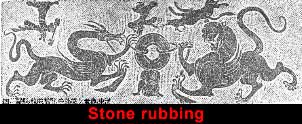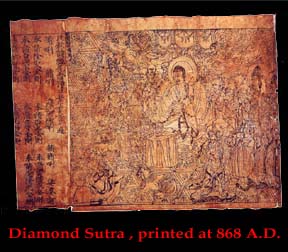The
historical background of practice of printing within Tibetan community
is closely related with the invention of woodblock  printing
in china
and its expansion to Asian countries. Paper, also like printing, had
its origin in China. And these two things are closely connected. Tibetan
culture adopted these technique from their neighbors along with many
other disciplines. So for reaching the historical back ground of these
practice we have to look back at the beginning and development of wood
block printing in China.
printing
in china
and its expansion to Asian countries. Paper, also like printing, had
its origin in China. And these two things are closely connected. Tibetan
culture adopted these technique from their neighbors along with many
other disciplines. So for reaching the historical back ground of these
practice we have to look back at the beginning and development of wood
block printing in China.
The earliest printed book ‘Diamond Sutra’ was
found in china. It was printed in 868 AD., by wood block printing method.
But the degree of perfection in printing we see in ‘Diamond Sutra’ manuscript
reveals a long way of effort and experimentation necessary for reaching
that stage (1).
In China the confusion scholars started to inscribe texts
in stone since in 206-220 AD. In Han dynasty. The use of seal was common
before that time. The Chinese word ‘Yin’ stands for seal means for clay
to paper. The use of it was mentioned in 255 BC. These were made of
many kind of material and the impressions were perfect, but the impressions
were often inkless, generally taken on clay. Before 55 AD. Seals were
often in white on red creating the illusion of an intaglio impression
or vice versa - the relief manner. Around 175-83 BC., Confucian and
Taoist classics began to cut in the stone and prints from those were
taken by ink rubbing.
The process of taking print was to put a sheet of thin, strong
moistened paper on the stone, and applying  pressure by a stiff brush so that the paper touch the lower surface
(inscribed area) of the stone. After the paper became dried a pad of
cloth, usually silk or cotton soaked well in sized ink was passed over
it. The ink was absorbed in non-engraved areas of the stone. When the
paper was taken away from the stone, it showed the text in white on
the black back ground.
pressure by a stiff brush so that the paper touch the lower surface
(inscribed area) of the stone. After the paper became dried a pad of
cloth, usually silk or cotton soaked well in sized ink was passed over
it. The ink was absorbed in non-engraved areas of the stone. When the
paper was taken away from the stone, it showed the text in white on
the black back ground.
The annals of the late Han dynasty (206 BC-2211
AD.) record the fact that the engraved stone tablets of the six classics,
was kept at the entrance of the Imperial academy. People came there
for copy it by the process of rubbing.
First cutting of images and character into
woodblocks happened in Tang dynasty (618AD.-966AD.). Mainly these were
religious doctrines -Buddhist, Taoist, Confucian and Christian. In 7th
century AD. experimentation in Buddhist monasteries took place. This
included various types of Buddha stamps, textile prints, stencils etc.
These printing were performed for devotional purpose. Mahayana Buddhist
made their theology with thousand Buddhas. Beside the human Buddha Sakyamuni
Gautama, son of Suddhodhana, the chief of Sakya tribe, who was born
2500 years ago, who was a historical character - these thousand Buddhas,
and Bodhisattvas are images of enlightened beings, the saviour of mankind.
For visualizing the innumerable Buddha images, the monk-artists took
the chance of printmaking. Countless images of Buddha were found printed
on paper on scrolls. One such scroll is kept in British museum display
480 impressions of the same image in 17 ft. long scroll.
In the Book by T.F. Center named ‘Invention of printing in China
and its spread west ward,’ we found the earliest known authentic
block print dates from 770 AD. came from Japan. These were one million
charms in Sanskrit and Chinese characters (2).
 At
last 868 AD. Buddhist monastery in tun Huang cave in Chinese Turkistan
‘Diamond Sutra’ earliest known dated block book printed . It was dedicated
"for universal free distribution by Wang Chieh to perpetuate the
memory of his parents. In 1907 Sir Aurelstein discovered Tun Huang cave
which was founded in 366 AD. He found 1500 scrolls, texts and books
among with Diamond sutra in a manuscript chamber sealed during the 10th
century (3).
At
last 868 AD. Buddhist monastery in tun Huang cave in Chinese Turkistan
‘Diamond Sutra’ earliest known dated block book printed . It was dedicated
"for universal free distribution by Wang Chieh to perpetuate the
memory of his parents. In 1907 Sir Aurelstein discovered Tun Huang cave
which was founded in 366 AD. He found 1500 scrolls, texts and books
among with Diamond sutra in a manuscript chamber sealed during the 10th
century (3).
Tun huang scrolls especially the diamond sutra is an example
of transformation of a scroll to book. A little sutra of 8 pages printed
on one side and folded like a modern day folder. Some western scholars
who have put much emphasis on John Guttenberg as pioneer of printing
do not consider Eastern civilization as cradle of printing According
to their viewpoint the invention of movable type is the beginning of
printing, But one thing we must keep in mind that in East Asia specially
china using movable type was not very economical because the Chinese
had 40,000 characters in their writing where the Europeans had merely
a few alphabets. However the Chinese also invented movable type before
European at 1041 AD. Bi Sheng invented this. Around 1200 AD. moveable
type was widely used in Korea(4).
American Scholar T.F. Carter wrote in his book ‘The
invention of printing and its spread westward’-For printing and
the invention of printing is the invention of that form of printing
which transform the education and culture of nation"(5).
This was the beginning, of printing manuscript and it continued.
So as the result of this continuities Tibetan community also inherited
this process for duplicating their sacred texts.
The another important factor in printing books or scrolls is
the surface for printing : The paper. Paper also was first made in China.
Before inventing the paper various materials were used for writing propose.
In India Birch bark was used for manuscripts. But in China birch bark
never had been used for writing purpose. Other materials such as animal
bones, tortoise shells, stone, clay, wood, bamboo, metal, silk had been
widely used. At 105 AD Tsai Lun invented the manufacture of paper. It
was Han dynasty (200BC.-200AD.), when the rise of burocracy demanded
the need of writing materials. Tsai Lun made paper from rags and raw
fibers. After invention of paper gradually it became a very popular
writing material and by end of 5th century all Central Asia started
to use paper. This way from China the knowledge of paper making introduced
to Tibet. But after 1200 AD. , technically we see no sign of development.
Still now Tibetan papermakers follow the same process from the beginning
time. The craft of paper making introduced to Tibet influenced areas
like Sikkim, Nepal, Bhutan, Ladakh at 1000 AD.Tamang horse riders who
had been spread over these Himalayan countries, since 700 AD.- were
possibly bearer of this technology(6).
The next important thing is the printing ink. This was earlier used
at 100 BC. ( Shung period). The Chinese made black ink of burnt wood
on lacquer mixed with glue and formed into a paste or brick, which is
soluble in water. Cinnabar red was also used and it was widely used
besides black.
The wood for making the block was usually pear or jujbe. The wooden
plank was clear cut, the surface of the plank very careful flattened
and sized with rice flour paste.
Though the use of paper was introduced to Tibet earlier, manuscript
from that time we found is hand written.
In 1334 the compilation of ‘KANJUR’ (Translation of the words of Buddha)
and TENJUR (Translation of treatise) ended. Kanjur contains 4500 works.
This huge task was performed by great Tibetan scholar Bu-Ston (1290Ad.-1364AD.).
A master copy of Tenjur was deposited at Zhalu monastery between Shigatse
and Syantse.
In 1410 one edition of Kanjur was printed in Peking. It was the first
printed Tibetan manuscript So we may assume from that time practice
of printing introduced to Tibetan community. Later we see printing presses
in all large monasteries of Tibet and Himalayan countries. But it is
very difficult to find any distinct historical record of these presses
and its activities throughout the centuries.
One reason behind it may be that the total emphasis of the printing
process was on making sacred texts and ritual oriented objects
( such as banner, images, diagram etc). And it had so strong ritualistic
purpose in its formation, that it was never considered as a separate
discipline to study. So the user of it remained more or less unaware
of its historical importance from technical or artistic view point.